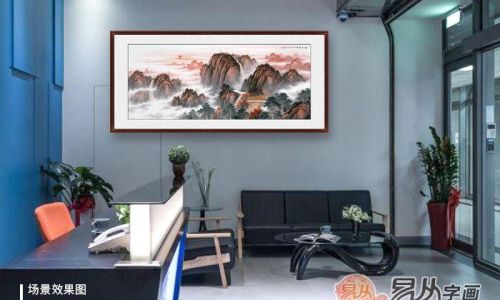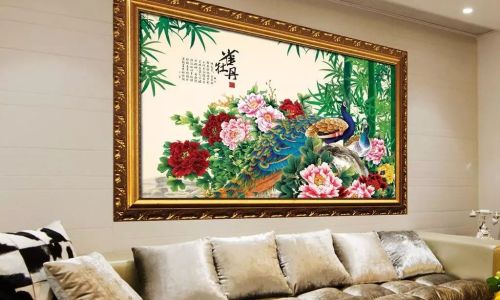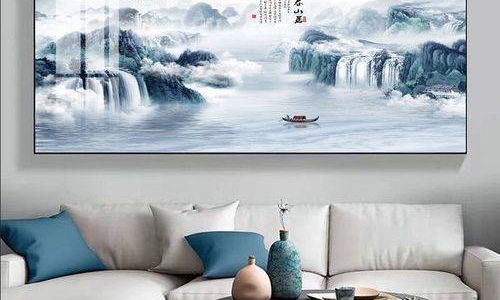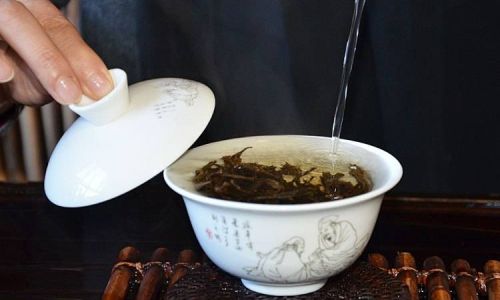In modern workplaces, office decor is no longer limited to functional furniture and neutral color schemes. Many professionals now incorporate artwork to inspire creativity, reduce stress, and reflect personal style. However, in Feng Shui—the ancient Chinese practice of harmonizing energy—the placement and subject matter of paintings hold significant symbolic weight. Choosing the wrong artwork or hanging it in an inappropriate location can disrupt the flow of Qi (energy), leading to career stagnation, interpersonal conflicts, or financial losses. This article explores 15 critical Feng Shui taboos for office paintings, offering practical guidance to align your workspace with positive energy.
Avoid Paintings of Ferocious Animals or Wild Beasts
While images of lions, tigers, or eagles might seem powerful, they embody aggressive Yang energy. In Feng Shui, such imagery can create a hostile atmosphere, fostering tension between colleagues or impulsiveness in decision-making. For example, a painting of a roaring tiger facing your desk may subconsciously provoke confrontations. Opt instead for serene animals like horses (symbolizing ambition) or cranes (representing longevity), ensuring their gaze is directed inward, not outward.
Steer Clear of Solitary Mountains or Desolate Landscapes
Paintings featuring isolated peaks, barren trees, or stormy seas evoke loneliness and hardship. Feng Shui emphasizes the importance of “support” in career growth—a concept symbolized by mountains. A lone mountain suggests a lack of mentorship or collaboration, while desolate scenes may mirror feelings of burnout. Replace these with lush, layered landscapes where mountains are backed by forests or rivers, signifying a strong support network and steady progress.

Banish Imagery of Decay or Despair
Artworks depicting withered leaves, broken bridges, or sunset scenes carry negative connotations of decline and farewell. Such imagery subconsciously programs the mind to focus on failures rather than opportunities. A painting of autumn leaves, though aesthetically pleasing, might inadvertently sap motivation. Choose vibrant, thriving scenes instead—spring blossoms, blooming flowers, or bustling cityscapes—to invigorate ambition.
Limit Excessive Red or Fiery Colors
While red symbolizes passion and recognition, an overabundance can trigger aggression or anxiety. In Feng Shui, the Fire element (associated with red) should be balanced, especially in high-pressure environments. A painting dominated by crimson hues might overwhelm the office’s energy, leading to heated arguments. Use red sparingly as an accent color, pairing it with calming tones like blue or green to maintain equilibrium.
Avoid Abstract Art with Chaotic Patterns
Abstract paintings featuring jagged lines, splatters, or disjointed shapes can create mental clutter. Feng Shui prioritizes clarity and order; chaotic art may disrupt focus, making it harder to concentrate on tasks. If you prefer abstract styles, select pieces with flowing, harmonious forms that evoke balance, such as circular motifs or gradient color transitions.
Never Hang Paintings with Mirrors or Reflective Surfaces
Mirrors in artwork (or standalone mirrors facing the desk) amplify energy—sometimes excessively. In Feng Shui, mirrors can reflect negative Qi back at the viewer or magnify stress. A painting with a mirrored lake, for instance, might double the pressure of deadlines. Opt for matte finishes or non-reflective materials to stabilize the energy flow.

Say No to Wilted Plants or Dead Floral Arrangements
Even if the artwork isn’t literal, themes of decay—such as drooping flowers or brown leaves—signal stagnation. Plants in Feng Shui represent growth and vitality; their wilted counterparts imply neglect. Replace these with paintings of thriving bamboo (flexibility), lotus flowers (purity), or bamboo groves (resilience) to foster a nurturing environment.
Avoid Weaponry or Sharp Objects
Swords, daggers, or pointed shapes in artwork introduce violent Sha Qi (killing energy). Even historical battle scenes can subconsciously raise defensiveness among team members. Instead, choose symbols of harmony, such as calligraphy scrolls with the word “harmony” (He) or paired mandarin ducks (symbolizing partnership).
Shun Dark, Gloomy, or Haunting Themes
Paintings of ghosts, ghouls, or stormy nights invite fear and uncertainty. Feng Shui links darkness to the Water element’s excess, which can drown motivation. Ensure your office artwork leans toward brightness—sunlit meadows, clear skies, or glowing lanterns—to uplift spirits and clarity.
Do Not Hang Paintings Too High or Too Low
Proper placement is as crucial as the artwork itself. Paintings hung too high may create a sense of unattainability, while those too low can symbolize being “weighed down.” The center of the artwork should align with eye level when seated, promoting a sense of control and accessibility.

Avoid Facing the Door Directly
In Feng Shui, the Command Position—where your desk faces the door—is ideal for awareness and opportunity. However, a painting directly opposite the door can block incoming Qi. If unavoidable, choose a piece with soft, welcoming imagery, like a meandering path or open gates, to guide energy gently inward.
Steer Clear of Crowded or Cluttered Compositions
Overly busy paintings with too many elements overwhelm the senses. Feng Shui advocates simplicity to avoid mental fatigue. A cluttered cityscape, for example, might mirror a chaotic workload. Opt for minimalist designs or focused subjects to maintain mental clarity.
Banish Paintings of Lonely Figures
Solitary figures in artwork—such as a lone hiker or a single tree—can amplify feelings of isolation. In team-oriented offices, such imagery may hinder collaboration. Replace isolated subjects with group scenes, like a team sailing a boat or a community garden, to encourage unity.
Avoid Religious or Spiritual Symbolism
While personal beliefs vary, religious icons (Buddhas, crosses, etc.) in shared offices may alienate colleagues or create discomfort. Feng Shui emphasizes neutrality in communal spaces. Reserve religious art for private areas, and opt for universal symbols like the Laughing Buddha (which is more widely accepted) or the Infinite Knot for harmony.

Do Not Mix Conflicting Elements
Combining incompatible Feng Shui elements—like Fire (red) and Water (blue)—in one painting can cause internal conflict. For instance, a fiery sunset over a tranquil lake creates elemental clashes. Choose artworks that harmonize elements, such as Wood (green) and Water (blue) to nurture growth, or Earth (yellow) and Metal (white) for stability.
Final Tips for Office Artwork Selection
- Prioritize Balance: Seek paintings with symmetrical compositions and balanced colors.
- Personal Connection: Choose art that resonates emotionally, as positive feelings amplify good Qi.
- Regular Updates: Rotate artwork seasonally to refresh energy and prevent stagnation.
By adhering to these Feng Shui principles, your office can transform into a sanctuary of productivity, creativity, and harmony. Remember, the goal is not superstition but intentionality—using art to subtly guide energy toward your professional aspirations.





0 comments